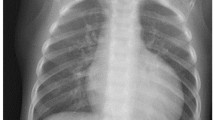Abstract
Primary persistent hyperinsulinaemic hypoglycaemia is characterised by clinical symptoms that occur when blood glucose levels drop below the normal range. Diazoxide treatment remains the mainstay of medical therapy. Tolerance of diazoxide is usually excellent, but several side effects of this drug have been described. We present a 4-month-old girl who developed pulmonary hypertension, heart failure and neutropenia during diazoxide therapy. Diazoxide toxicity was suspected and the drug was withdrawn on day 13. During the next 3 days, respiratory and haemodynamic status dramatically improved and she was weaned from mechanical ventilation. Control white blood cell count was 8800 cells/mm3 and a new echocardiography showed modreduction of pulmonary artificial pressure to 20 mmHg and resolution of atrial and ventricular enlargement. Paediatric physicians should be in mind of pulmonary hypertension, heart failure and neutropenia developing during diazoxide therapy.
Similar content being viewed by others
References
Stanley CA. Hyperinsulinism in infants and children. Pediatr Endocrinol. 1997;44:363–374.
Fernandes J, Berger R. Hypoglycemia: principles of diagnosis and treatment in children. Gregory JW, Aynsley-Green A, eds. Hypoglycemia. Baillieres Clin Endocrinol Metab. 1993;7:591–609.
Touati G, Poggi-Travert F, Ogier de Paulny H, et al. Long-term treatment of persistent hyperinsulinaemic hypoglycemia of infancy with diazoxide: a retrospective review of 77 cases and analysis of efficacy-predicting criteria. Eur J Pediatr. 1998;157:628–633.
Abu-Osba YK, Manasra KB, Mathew PM. Complications of diazoxide treatment in persistent neonatal hyperinsulinism. Arch Dis Child. 1989;64:1496–1500.
McGraw ME, Price DA. Complications of diazoxide in the treatment of nesidoblastosis. Arch Dis Child. 1985;60:62–64.
Parker JJ, Allen DB. Hypertrophic cardiomyopathy after prolonged diazoxide therapy for hyperinsulinemic hypoglycemia. J Pediatr. 1991;118:906–909.
Combs JT, Grunt JA, Brandt IK. Hematologic reactions to diazoxide. Pediatrics. 1967;40:90–92.
Roy R, Couriel JM. Secondary pulmonary hypertension. Paediatr Respir Rev. 2006;7:36–44.
Silvani P, Camporesi A, Mandelli A, Wolfler A, Salvo I. A case of severe diazoxide toxicity. Pediatr Anaesthesia. 2004;14:607–609.
Gillies DR. Complications of diazoxide in the treatment of nesidioblastosis. Arch Dis Child. 1985;60:500–501.
Aynsley Green A, Polak JM, Bloom SR, et al. Nesidioblastosis of the pancreas: definition of the syndrome and the management of the severe neonatal hyperinsulinemic hypoglycemia. Arch Dis Child. 1981;56:496–508.
Author information
Authors and Affiliations
Corresponding author
Rights and permissions
About this article
Cite this article
Yildizdas, D., Erdem, S., Küçükosmanoǧlu, O. et al. Pulmonary hypertension, heart failure and neutropenia due to diazoxide therapy. Adv Therapy 25, 515–519 (2008). https://doi.org/10.1007/s12325-008-0049-3
Published:
Issue Date:
DOI: https://doi.org/10.1007/s12325-008-0049-3




